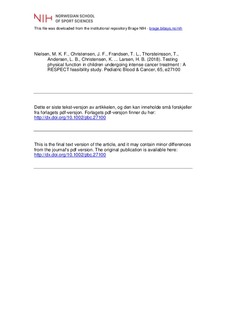Testing physical function in children undergoing intense cancer treatment: A RESPECT feasibility study
Nielsen, Martin K F; Christensen, Jesper F; Frandsen, Thomas L.; Thorsteinsson, Troels; Andersen, Lars Bo; Christensen, Kari; Nersting, Jacob; Faber, Marianne; Schmiegelow, Kjeld; Larsen, Hanne B
Journal article, Peer reviewed
Accepted version
Permanent lenke
http://hdl.handle.net/11250/2597732Utgivelsesdato
2018Metadata
Vis full innførselSamlinger
- Artikler / Articles [2119]
- Publikasjoner fra Cristin [1107]
Sammendrag
Background: The physical function of children with cancer is reduced during treatment, which can compromise the quality of life and increase the risk of chronic medical conditions. The study, “REhabilitation, including Social and Physical activity and Education in Children and Teenagers with cancer” (Clinicaltrials.gov: NCT01772862) examines the efficacy of multimodal rehabilitation strategies introduced at cancer diagnosis. This article addresses the feasibility of and obstacles to testing physical function in children with cancer.
Methods: The intervention group comprised 46 males and 29 females aged 6–18 years (mean ± SD: 11.3 ± 3.1 years) diagnosed with cancer from January 2013 to April 2016. Testing at diagnosis and after 3 months included timed‐up‐and‐go, sit‐to‐stand, flamingo balance, handgrip strength, and the bicycle ergometer cardiopulmonary exercise test (CPET).
Results: Of the 75 children, 92% completed a minimum of one test; two children declined testing and four were later included. Completion was low for CPET (38/150, 25%) but was high for handgrip strength (122/150, 81%). Tumor location, treatment‐related side effects, and proximity to chemotherapy administration were primary obstacles for testing physical function. Children with extracranial solid tumors and central nervous system tumors completed significantly fewer tests than those with leukemia and lymphoma. Children with leukemia demonstrated reduced lower extremity function, that is, 24% reduction at 3 months testing in timed‐up‐and‐go (P = 0.005) and sit‐to‐stand (P = 0.002), in contrast with no reductions observed in the other diagnostic groups.
Conclusion: Children with cancer are generally motivated to participate in physical function tests. Future studies should address diagnosis specific obstacles and design testing modalities that facilitate physical function tests in this target group.
Beskrivelse
I Brage finner du siste tekst-versjon av artikkelen, og den kan inneholde ubetydelige forskjeller fra forlagets pdf-versjon. Forlagets pdf-versjon finner du på wiley.com / In Brage you'll find the final text version of the article, and it may contain insignificant differences from the journal's pdf version. The definitive version is available at wiley.com
